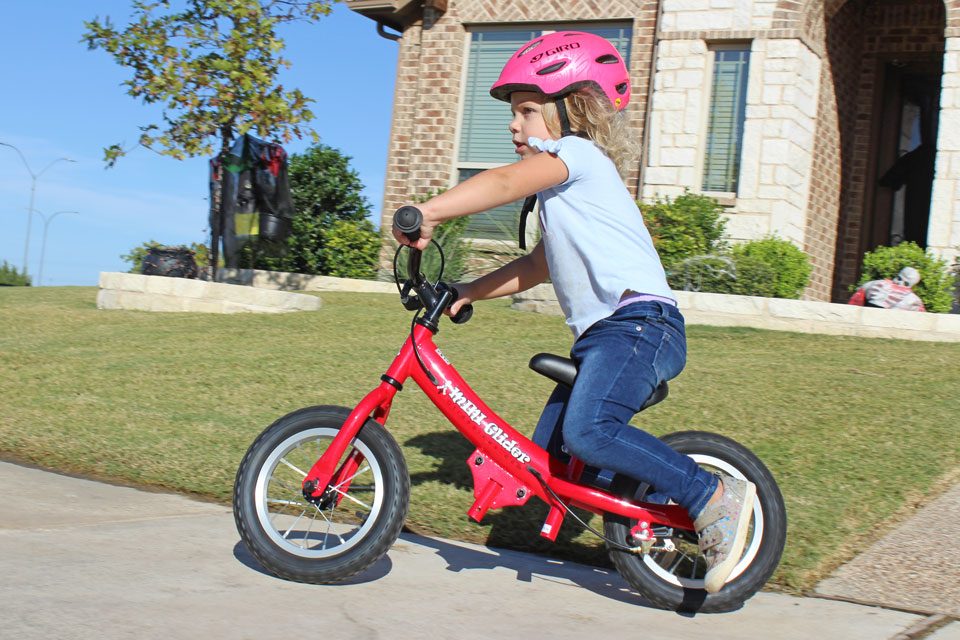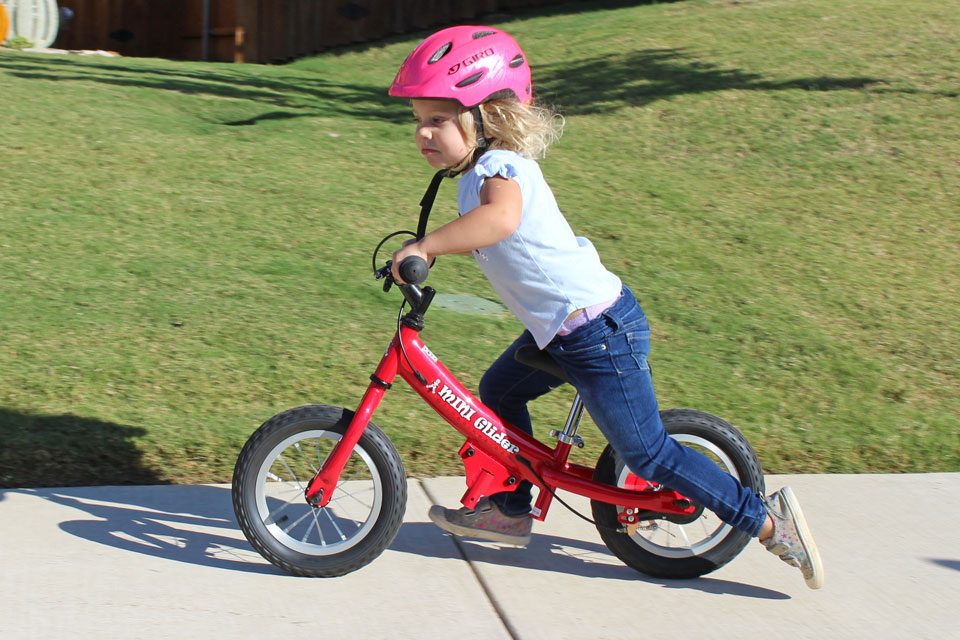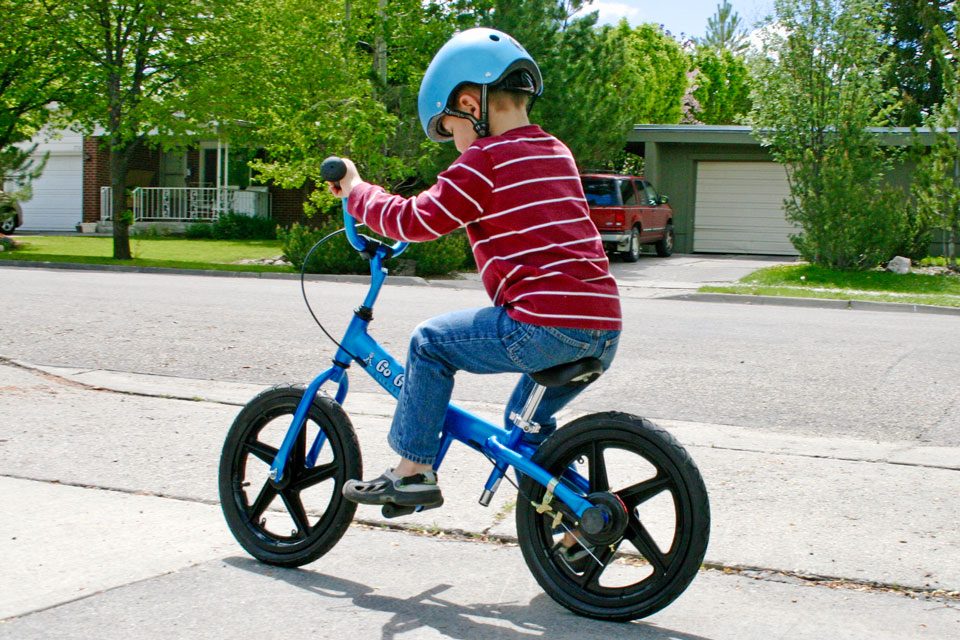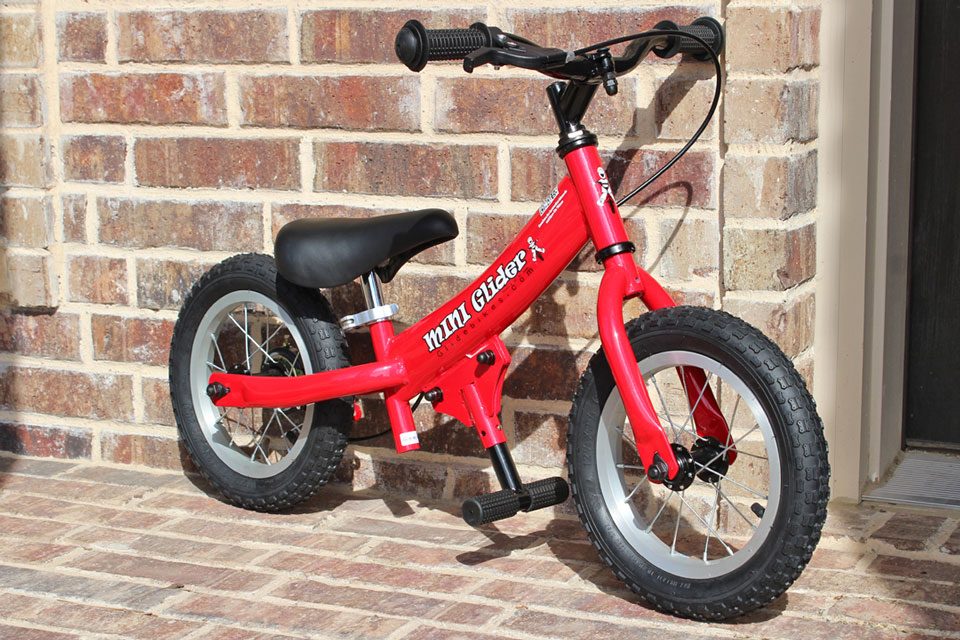Glide Bikes was one of the first brands on the balance bike scene. Offering three different size balance bikes, they’ve designed a family of glider bikes that will fit your little one whenever they start their balance bike journey.
In this glider bike review, we’ll cover the Glide Bike’s standard 12″ balance bike, called the Mini Glider. The Ezee Glider is a smaller glider bike for toddlers with foam tires, while the Go Glider is the largest offering. With 16″ air tires, the Go Glider balance bike is great for kids 5 and older. All three bikes are similar, so this review of the Mini Glider will give you a good feel for the other sizes as well.

Glider Bike Review – Mini Glider

RATING: Recommended
MSRP: $89 (Currently out of stock)
BEST FOR: Kids in size 2T to 4T clothes
SEAT HEIGHT: 12.5″ – 15.75″
WEIGHT: 11.7 lbs. (without footrest)
TIRES: 12″ air
PROS:
- Versatile tread air tires for great cushioning and traction
- Wide handlebars for increased steering stability
- Adjustable height handlebars
- Seat post has a quick release clamp for easy height adjustments
- Unique footrest can easily be removed for kids who don’t want to use it
- Durable frame will last through several kids
CONS:
- Heavy steel frame
- Handlebar grip ends tear easily
- Limited room for growth (just over 3″)
- Our handbrake needed a complicated adjustment before it would work properly
Glider Bike Review – Results of our Test Rides
Performance

We had three different toddlers test the Mini Glider. Two of them were already skillful balance bike riders, while the other was confident on other balance bikes, but was still developing her skills.
Our 3 and 4 year old balance bike masters had no difficulty riding the Mini Glider, riding and gliding with ease down the neighborhood sidewalks. They could lift their feet up to balance, make sharp turns, and lean in to run hard and get aggressive.
Our younger rider with fewer riding hours under her belt had a different experience. While she rides other balance bikes with ease, she struggled with the Mini Glider. Her steering was very twitchy and she wasn’t in solid control of the bike. While we can’t pinpoint the reason, we hypothesize that is could be that the Mini Glider is several pounds heavier than other balance bikes she rides.

Glider Bike Sizing
With a seat height range of 12.5″ – 15.75″, the Mini Glider has just over 3″ of seat height adjustment. We prefer to see 4″ or more from min to max. Kids grow like crazy during their toddler years, so having plenty of room for growth is pretty important.
That said, there are many balance bikes under $100 that have only 3″ of seat height adjustment. But if you think your child will be growing quickly, you may want to look for a bike with a bit more growth, like the Banana Bike GT that has 4.5″ of seat height growth. (12.5″ – 17″)
For reference, the toddler below is 39.5″ tall. The bike is a great fit for her – with a longer wheelbase she has plenty of room in the cockpit to maneuver the bike. The seat is set to 15.25″ so she has just a bit more room to grow until she maxes out at 15.75″.

The larger 16″ Go Glider is quite a bit bigger than the Mini Glider, with handlebars that are much higher. Based on our testing, it’s a best fit for an average sized 5 year old or taller. In the image below, we have our very tall 4.5 year old in size 6 clothes.

12″ Air Tires for Cushioning and Traction
The Mini Glider’s 12″ air tires with versatile tread are the star feature of this little bike. Air tires are far superior to the foam tires found on many balance bikes, including the Glide Bikes Ezee Glider.
Air tires provide much needed cushioning as kids get more aggressive and start riding over curbs, rocks, and ramps. Traction is also superior, which allows kids to safely ride over a wide variety of surfaces – from smooth gym floors to dirt trails.

Steel Frame is Heavy
At 11.7 lbs., the Mini Glider is one of the heaviest balance bikes on the market. Its durable steel frame is sure to last many years, but the weight is concerning. Based on the seat height, this bike is marketed to an average 2 year old. Almost 12 pounds of bike is a lot to handle for a young child still developing muscle strength and coordination. Especially when other bikes in the same price range (or cheaper) are only 6 – 8 pounds.

Hand Brake
The Mini Glider features a single hand drum brakes. Drum brakes are not common, but generally require little maintenance. They are also less affected by wet riding conditions. On the flip side, they are usually heavier than standard v-brakes found on most balance bikes with brakes.

The Mini Glider is the only balance bike under $100 (that we’ve seen) that features a hand brake. While we certainly appreciate a handbrake on a balance bike, the brake cable on our Mini Glider wasn’t adjusted properly and the tension was too tight for our toddler testers to engage the lever. We have a friend with a Glide Bikes Ezee Glider who has the same issue, and her son is unable to use the brake.
This tension can be adjusted, but drum brakes are not common, so you may end up needing to take it to a bike shop to fix. Most balance bikers use their feet to brake anyways, so the bike is still safe to ride if your brake has a problem

Headset and Handlebars
The quill headset of the Mini Glider has 1″ of adjustability. This allows you to raise the handlebars a bit for a more comfortable fit for older riders.
At 17″ wide, the handlebars are wider than most and provide nice stability for little riders. Handlebars that are more narrow can cause twitchy steering. As a comparison, the Yeedoo Too Too’s handlebars are just 13.75″ wide, while the Vitus Smoothy has 16″ wide handlebars.

The grips on the end of the handlebars tear easily. After just a few uses (and our toddler throwing the bike on the ground per usual), the metal end of the handlebar had broken through the end of the grip.

Saddle and Seat Post
The Mini Glider’s saddle is firm but lightly padded. It is not sized down for the proportions of a toddler’s body, and is quite large.
The seat height of the bike is easily adjustable with a quick release clamp.

Footrest
The footrest on the Glider Bikes is a pretty cool design. The footrest is two pegs that stick out to the sides underneath the bike. But if you don’t want to use the footrest, you simple turn it parallel to the bike’s frame so that it’s completely out of the way. You can also just remove it entirely to save on a little weight.

Some kids really love to use a footrest, while others just ignore them. We love that Glider Bikes’ design accounts for both types of kids and lets you customize your bike accordingly. Older kids are more likely to use a footrest, so it’s certainly a nice addition to the larger 16″ Go Glider, as seen below.

Bottom Line on the Mini Glider Balance Bike
The Glide Bikes Mini Glider is a durable and decent little balance bike. However, it’s quite heavy and has limited room for growth. While it truly is a fine little balance bike, there are several better options that are lighter and also cheaper.
FTC Disclosure: Affiliate links are included in this review. No monetary compensation was provided for this review, however, the reviewed product was supplied by the manufacturer or distributor to help facilitate this review. All opinions and images are that of Two Wheeling Tots LLC. All content and images are copyrighted and should not be used or replicated in any way. View our Terms of Use.
